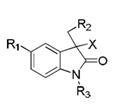Never miss an update from Universidad de Alcalá-OTRI
Create your free account to connect with Universidad de Alcalá-OTRI and thousands of other innovative organizations and professionals worldwide
The research group of “Neuroendocrinology of the cannabinoid / vanilloid system” of the University of Alcalá, in collaboration with researchers from the Institute of Medical Chemistry of CSIC, have developed a series of compounds derived from indolin-2-one, emphasizing the pharmaceutical compositions containing in the compounds and their use for the treatment of diseases mediated by AMPK (AMP-activated kinase), particularly inflammatory, autoimmune, metabolic, cardiovascular, neurological and cancer.
The group is looking for companies in the pharmaceutical and health sector with the objective of reaching technical cooperation agreements, commercial agreements with technical assistance or patent licensing.
The invention relates to a compound whose base formula (I) is:

Where O represents a pharmaceutically acceptable salt thereof, wherein X represents hydrogen or halogen; R1 represents hydrogen or halogen; R2 represents phenyl or Cy1 and R3 represents hydrogen or a group of formula:

And the rest of the realizations of the formula. The compounds of formula (I) and their salts may differ in certain physical properties, but are equivalent for purposes of the invention.
Other aspects of the invention are related to:
- pharmaceutical composition comprising a compound of formula (I) as defined above and one or more pharmaceutically acceptable excipients thereof.
- use of a compound of formula (I) for the manufacture of a medicament for the treatment of a disease associated with the modulation of the AMPK enzyme, such as autoimmune, inflammatory, cardiovascular, metabolic, neurological and cancer diseases, more preferably where the disease is selected from diabetes type 1 and 2, obesity, inflammation, dyslipidemia, hypertension, hyperglycemia, hypertriglyceridemia, insulin resistance, epilepsy, stroke, Krabbe / Twitcher diseases, Alzheimer's, Parkinson's, Huntington's and cancer, even more preferably where the disease is cancer; and still more preferably where the disease is prostate cancer, breast cancer, pancreatic cancer, uterine cancer and gliomas.
The compounds of formula (I) can exist in different physical forms, for instance, in amorphous form and crystalline forms.
As for its pharmaceutical composition, it comprises a compound of the invention (or a pharmaceutically acceptable salt or solvate) and one or more pharmaceutically acceptable excipients. The excipients must be "acceptable" in the sense of being compatible with the other ingredients of the composition and not being harmful to whoever takes said composition.
As for the administration of the compounds, this can occur in several formulations: oral, parenteral, nasal, ocular, rectal, and topical.
Current development status
Experimental technologies
Applications
Therapeutic use for the treatment of diseases mediated by AMPK (AMP-activated kinase), particularly inflammatory, autoimmune, metabolic, cardiovascular, neurological and cancer.
Desired business relationship
Technology selling
Patent licensing
Technology development
New technology applications
The group is looking for companies in the pharmaceutical and health sector with the objective of reaching technical cooperation agreements, commercial agreements with technical assistance or patent licensing.
INNOVATIVE ASPECTS
This invention presents new indolin-2-one derivatives, which act as modulators of the AMP-activated kinase (AMPK). Any alteration in the correct functioning of AMPK is associated with numerous pathologies. The role of key modulator that AMPK plays in energy metabolism appears as a promising strategy for the prevention and treatment of metabolic diseases, highlighting the need to discover new compounds able to regulate energy metabolism through AMPK modulation.
Nothing similar has been found in patent databases or in the scientific literature consulted.
COMPETITIVE ADVANTAGES
The formulas described in the invention represent a novelty in terms of the modulation of the levels of AMP / ATP optimal concentrations, using derivatives of indolin-2-one, which act as modulators of AMPK, whose decompensation is related to the appearance of metabolic diseases, cancer, etc., which represents an advantage with respect to the products currently in the market.
The administration of the compounds can be done in several formulations: oral, parenteral, nasal, ocular, rectal, and topical, which significantly improves their use.
It presents commercial potential at a national and international level, with reasonable difficulty and implementation cost.
The Technology Transfer Office at Alcalá University serves as a liaison between the University and its socioeconomic environment in terms of research and innovation. It encorages collaboration between research groups from universities and companies/institutions, with the objective to promote and commercialize research results and scientific capabilities.
Some of the services offered by this office are specified in the following list:
- Promotion of R & D and improvement of the relationships with companies.
- Promote the participation in R & D projects applicants to public calls (regional, national and European).
- Advising, processing and monitoring of patents and other forms of industrial protection.
- Support in the negotiation of contracts and agreements for R&D&i
Create your free account to connect with Universidad de Alcalá-OTRI and thousands of other innovative organizations and professionals worldwide
Send a request for information
to Universidad de Alcalá-OTRI
Technology Offers on Innoget are directly posted
and managed by its members as well as evaluation of requests for information. Innoget is the trusted open innovation and science network aimed at directly connect industry needs with professionals online.
Need help requesting additional information or have questions regarding this Technology Offer?
Contact Innoget support